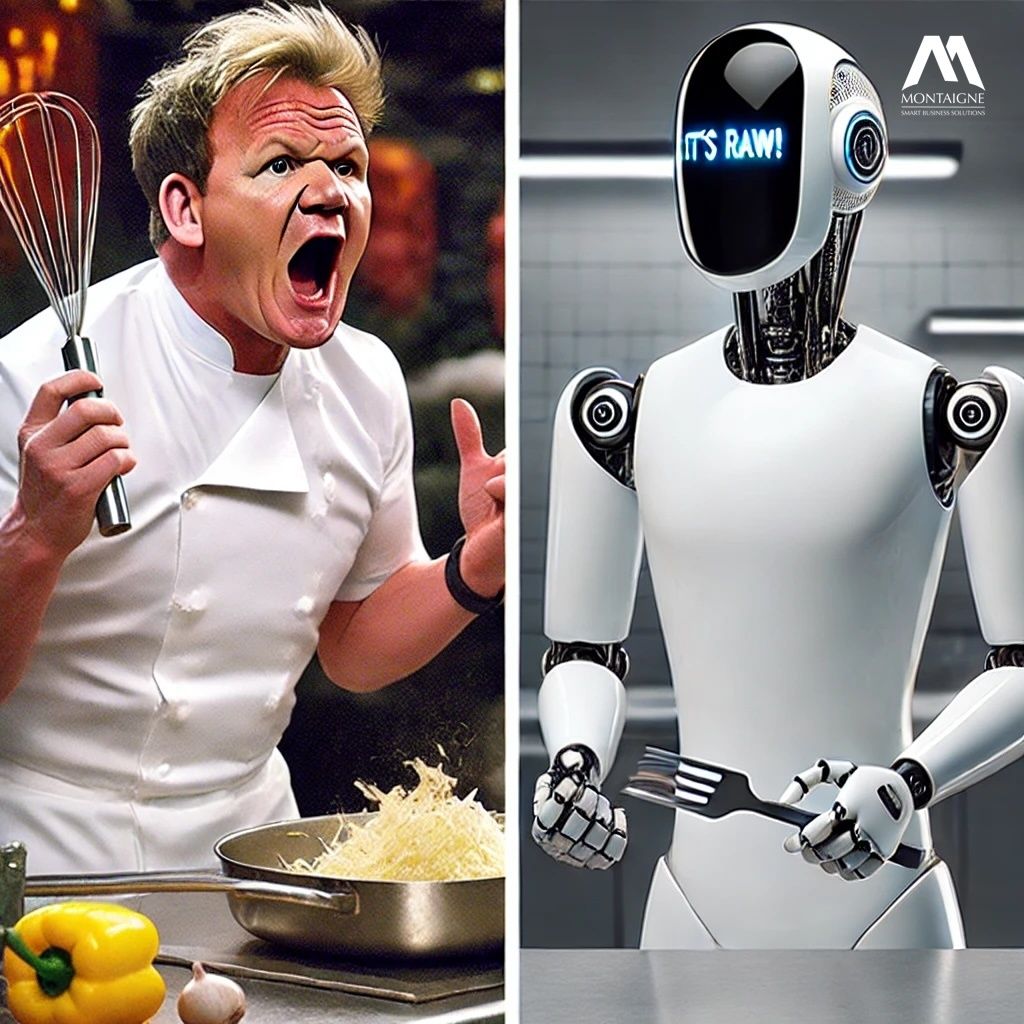- Montaigne Launch Labs
- Posts
- The Robot Revolution: From Kitchen to Campus
The Robot Revolution: From Kitchen to Campus
Your weekly dose of Business Architecture and 'Disruptive' Discussions
In a world where Elon Musk seeks humans to impersonate robots, real robots are busy flipping burgers, crafting gourmet meals, and even mimicking celebrity chefs. Welcome to the brave new world of culinary automation, where your next meal might just be cooked by an algorithm. Founders, are you ready to feast on the future?

When AI finally understands sarcasm. Source: Montaigne
Market Reality Check
The kitchen of tomorrow is here today, and it's powered by circuits instead of gas. Let's dive into the sizzling world of robo-chefs:
Global Appetite: The food robotics market is projected to grow at a mouthwatering CAGR of 12.7% till 2030 (Source: Montaigne Insights).
Diverse Implementations: From Kaikaku's conveyor belt system in London to FIU's "Beastro" in Florida, robots are taking on various forms and functions in the kitchen.
Investment Landscape: While some investors like Mark Cuban are cautious, others see potential. RoboBurger secured a $1.5 million loan on Shark Tank, valuing the company at $16.5 million.
Technological Advancements: The World Robot Conference in Beijing showcased robots emulating Gordon Ramsay's skills, indicating a leap from simple tasks to complex culinary techniques.
Market Challenges: High initial costs ($30,000 to $300,000 per system) and concerns about job displacement remain significant hurdles.
Startup Spotlight: From Burgers to Bowls
Kaikaku (London):
Founded by 23-year-old Josef Chen
Raised $2.5 million, with more funding expected
Uses a factory-like assembly system for food preparation
Motivated by automating tedious kitchen tasks
RoboBurger (USA):
Vending machine that cooks burgers in under 4 minutes
Secured $1.5 million loan on Shark Tank
Business model involves selling/leasing machines to operators
Beastro at FIU (Florida):
Robotic system preparing fresh, gourmet meals for students
Capable of producing 75 dishes per hour
Self-cleaning functionality
User Pulse: The Taste Test
Consumer sentiment remains a mixed platter (Source: Montaigne Insights):
66% are intrigued by robot-prepared meals
74% would try out of curiosity
Only 27% comfortable with robots in high-end restaurants
43% concerned about losing the "human touch" in cooking
We went to a revolving sushi restaurant… a robot brought our drinks, a semi truck brought our edamame, a conveyor belt brought sushi, then the robot came back to sing her happy birthday! This is why we need @PLTWorg in schools… I felt like I was in an episode of the Jetsons!
— Mrs. Hawk PLTW KJH (@HawkPLTWKJH)
8:52 PM • Sep 5, 2024
RobinoVino - Robot-Sommelier - for your Winery, Bar, Restaurant, Hotel, etc.
— RobinoVino - Robot-Sommelier (@RobinoVino)
6:51 AM • Aug 15, 2024
Students at FIU have embraced Beastro, appreciating its efficiency and novelty. However, customization remains a challenge, with some lamenting the lack of a "guac option."

Source: Montaigne Launch Labs YouTube
The Architect's Dilemma: Cooking Up Strategies
Integration vs. Innovation: Retrofit existing kitchens or build new, automation-first concepts?
Market Positioning: Target institutional settings (like FIU's Beastro) or consumer-facing applications (like RoboBurger)?
Scalability vs. Customization: Balance efficiency with meeting diverse consumer preferences.
Funding Strategies: Consider alternative financing models, like RoboBurger's loan approach, to mitigate investor skepticism.
Technological Complexity: Decide between simpler, focused systems (like RoboBurger) or more advanced, multi-functional robots (like those at the Beijing conference).
Ethical Considerations: Address concerns about job displacement and maintain the "soul" of culinary experiences.
Data Utilization: Leverage the wealth of data generated by these systems for menu optimization and customer insights.
Closing Thoughts
As robots master the art of cooking, will the future of gastronomy lie in the imperfections and innovations only a human chef can provide? Or will we see a new culinary language emerge, born from the precision of machines and the creativity of human oversight?
The next course in this technological feast is yet to be served, but one thing's certain – the recipe for success in the food industry is being rewritten. Bon appétit, innovators!
Reply